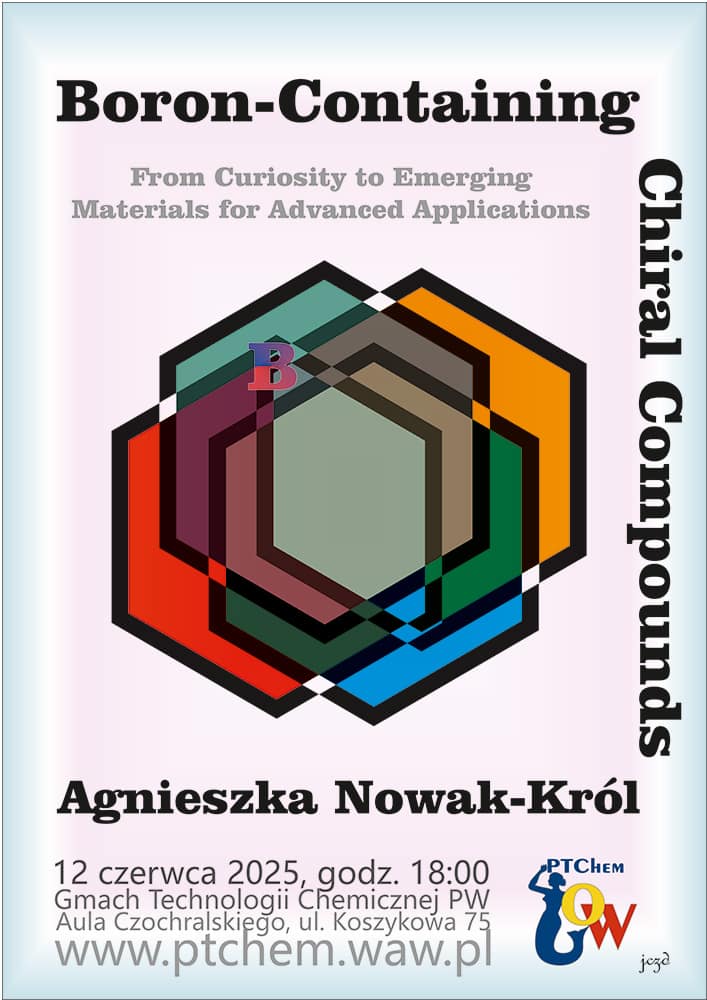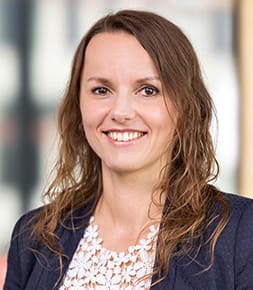
Wykład:
Boron-Containing Chiral Compounds: From Curiosity to Emerging
Materials for Advanced Applications
Agnieszka Nowak-Król (Wuerzburg University)
12 czerwca 2025 o godz. 1800 Gmach Technologii Chemicznej, Aula Czochralskiego, ul. Koszykowa 75.
The incorporation of boron and nitrogen into polycyclic aromatic hydrocarbons (PAHs) has become an established approach to modify their physical and optoelectronic properties.[1,2] These compounds with excellent characteristics, e.g. luminescence intensity or charge transfer properties, have been intensively investigated in bioimaging, organic electronics and photovoltaics.[3] Yet, the most noticeable achievements have been made in the field of achiral compounds, leaving an unexplored niche for chiral boron-doped materials. It is noteworthy that less than a decade ago, there were only a handful of boron-containing helicenes.[4] The lack of effective and reliable synthetic protocols limited their structural diversity, while other helicenes remained inaccessible. Recognizing the enormous potential of chiral boron-containing compounds, we chose their synthesis, study of their properties and application of these attractive compounds as our main research objective. Our motivation was to exploit their properties arising from their chirality, such as circularly polarized (CP) luminescence and packing arrangement, in CP-OLEDs, transistor devices, and bioimaging. Over the last few years, we have systematically expanded the family of boron-doped chiral materials. Using our modular approach and new synthetic methods, we were able to prepare a variety of boron helicenes, including single helicenes, multihelicenes, boron-containing photoswitches, and boron-centered spiro compounds.[5-10]

In this talk, we will present selected boron-containing chiral compounds, i.e. π-extended helicenes containing multiple chiral axes, derived from dibenzo[g,p]chrysene derivatives with substitution patterns that are difficult to achieve, together with the key parameters that define their performance as functional chiral materials. We will also discuss the preparation of unique azaborathiahelicenes and boron-centered spiro compounds via our new protocols that proved critical in the synthesis of boron-containing photoresponsive materials.
References:
[1] von Grotthuss, A. John, T. Kaese, M. Wagner, Asian J. Org. Chem. 2018, 7, 37. [2] P. T. Geppert, D. Volland, K. Szkodzińska, A. Nowak-Król, Org. Mater. 2025, DOI: 10.1055/a-2603-4217. [3] S. K. Mellerup, S. Wang, Trends Chem. 2019, 1, 77. [4] A. Nowak-Król, P. T. Geppert, K. R. Naveen, Chem. Sci. 2024, 15, 7408. [5] J. Full, S. P. Panchal, J. Götz, A.-M. Krause, A. Nowak-Król, Angew. Chem. Int. Ed. 2021, 60, 4350. [6] F. Full, Q. Wölflick, K. Radacki, H. Braunschweig, A. Nowak-Król, Chem. Eur. J. 2022, 28, e202202280. [7] F. Full, M. J. Wildervanck, D. Volland, A. Nowak-Król, Synlett 2023, 34, 477. [8] D. Volland, J. Niedens, P. T. Geppert, M. J. Wildervanck, F. Full, A. Nowak-Król, Angew. Chem. Int. Ed. 2023, 62, e202304291. [9] J. Full, M. J. Wildervanck, C. Dillmann, S. P. Panchal, D. Volland, F. Full, K. Meerholz, A. Nowak-Król, Chem. Eur. J. 2023, 29, e202302808. [10] F. Full, A. Artigas, K. Wiegand, D. Volland,

